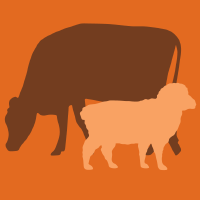Topic Menu
► Topic MenuTopic Editors


Rumen Fermentation, Microbial Population and Digestibility in Ruminants
Topic Information
Dear Colleagues,
Feed efficiency is a complex function of nutrient intake in relation to animal growth-performance potential. The windows of opportunity to increase feed efficiency are improves on fermentation and digestion, nutrient absorption, and/or on cellular metabolism. With regard to fermentation and digestion, roughly 80% of the total tract digestible organic matter intake is fermented in the rumen. Hence, understanding the principles of fermentative processes and the limits of the rumen function are key to optimizing nutrient utilization. Knowledge about the complex interactions between microorganisms and the ruminal environment are important research areas to better understand fermentation efficiency, nutrient digestibility, and health. The manipulation of the nutrient availability for microbial fermentation via feed processing and feeding management systems, and modulations in the characteristics of fermentation and ruminal pH by optimizing levels of effective fiber, and tailored use of feed additives are tools that have proven to be useful for this purpose. In addition to aspects directly associated with fermentative efficiency and health, per se, considerable research attention has been directed toward mitigation of methane emissions. In this Topic, we welcome research articles, as well as review articles focusing on: 1) diverse approaches toward mitigation of ruminal methane generation, 2) diet formulation, feeding management, and environmental factors affecting digestive dysfunctions and subacute acidosis 3) diet formulation and feeding management practices affecting ruminal pH and efficiency of ruminal microbial protein synthesis.
Dr. Alejandro Plascencia
Dr. Juan Ku Vera
Prof. Dr. Richard Avery Zinn
Topic Editors
Keywords
- ruminal fermentation
- digestive function
- ruminal metabolism
- ruminal microbiology
- manipulation rumen fermentation
- modeling digesta passage and fermentation
- methane
- acidosis
- feed additives
Participating Journals
| Journal Name | Impact Factor | CiteScore | Launched Year | First Decision (median) | APC |
|---|---|---|---|---|---|

Animals
|
3.0 | 4.2 | 2011 | 18.1 Days | CHF 2400 |

Ruminants
|
- | - | 2021 | 20.9 Days | CHF 1000 |

Sustainability
|
3.9 | 5.8 | 2009 | 18.8 Days | CHF 2400 |

Veterinary Sciences
|
2.4 | 2.3 | 2014 | 19.6 Days | CHF 2600 |

MDPI Topics is cooperating with Preprints.org and has built a direct connection between MDPI journals and Preprints.org. Authors are encouraged to enjoy the benefits by posting a preprint at Preprints.org prior to publication:
- Immediately share your ideas ahead of publication and establish your research priority;
- Protect your idea from being stolen with this time-stamped preprint article;
- Enhance the exposure and impact of your research;
- Receive feedback from your peers in advance;
- Have it indexed in Web of Science (Preprint Citation Index), Google Scholar, Crossref, SHARE, PrePubMed, Scilit and Europe PMC.


